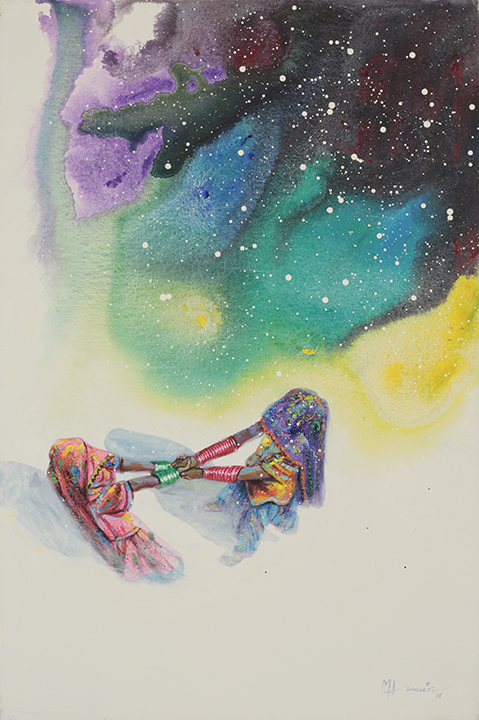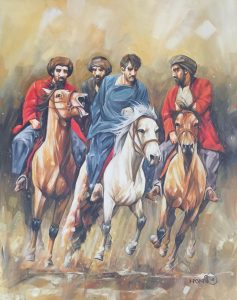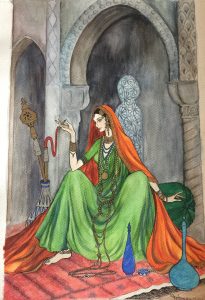A versatile artist who is constantly evolving, Rind is well-loved for the rich, vibrant colors of his canvases. He has exhibited extensively, with scores of group and solo shows to his credit, both in Pakistan and internationally. He has worked in impressionism, cubism, super-realism, abstracts and calligraphy, and has now turned to an exploration of figurative work, where he uses the colors, motifs and ethnic jewellery of his native southern Pakistan to great visual effect. Another hallmark of his work is the use of Faiz’s poetry and the incorporation of Urdu alphabet as a decorative motif rather than as coherent words. His elegantly stylized women, with their long necks and almond eyes, are painted with strong, sweeping, confident strokes. Parrots and fish make frequent appearances in his works, and he uses these elements to symbolize the absence of a lover, loneliness, and the human struggle against it.
With his representation of the nightlife of roadside cafés in Pakistan, Amjad’s work shows us the universality of the human condition and the need of urban dwellers to seek the outdoors. Outdoor café scenes have been painted by countless European masters; the cityscapes shown here could be those of any modern city, anywhere in the world. In his use of the thick impasto technique the strong lines and colors, the influence of Van Gogh is obvious in Amjad’s work.
While many Pakistani artists paint cityscapes, Amjad’s work is unique not only in presenting the nightlife of Lahore but also showing it as a universal theme and with a great love of light, line, and detail. His is a unique voice among Pakistani artists that are capturing and preserving, through their artwork, the landscapes and cityscapes of the Pakistan of yesterday and today.
Ashkal’s work is strongly influenced by cubism. His current series explores themes surrounding the senses. Sight, sound and smell are well explored, as evidenced by the appearance of musical instruments, flowers, birds and butterflies. The hypnotic effects of music are of particular interest to him, an effect magnified by the siren-like quality of his women. The decorative elements in his work are also fascinating because, while they are thoroughly modern in their angular, cubist rendering, they are also simultaneously reminiscent of ancient Egypt or Mesoamerican motifs. His color palette of mainly red, white, blue, yellow and black is likewise very modern yet each of these colors was also important in ancient Egyptian art and culture as symbolizing a certain meaning or emotion. Ashkal thus demonstrates that he is not only well-travelled, which indeed he is, but also that he has a fascination for diverse cultures and a healthy curiosity about them.
Ghayaz’s talent for sketching and drawing was noticed at a very young age by his elder brother who nurtured and encouraged it. This innate talent was further groomed under the tutelage of the legendary Eqbal Mehdi, under whom Asif studied extensively and whose influence can be clearly seen in his work. Ghayaz’s pen and ink portraits are so detailed, the figures so finely executed and posed so naturally within his compositions, that one feels almost as if one can reach out and touch them, while feeling simultaneously wary of intruding into their solitude and contemplation. The often half-hidden faces enhance the aura of mystery and aloofness of his women. The works in which he includes architectural details also demonstrate his mastery in creating minute decorative detail, depth, and three-dimensional space. Ghayaz is shown extensively in art galleries all over Pakistan and has also worked for the Aga Khan University Hospital for several years with his work depicted in their calendars greeting cards and newsletters.
Asrar started his career at a young age, painting advertising signboards. He then moved on to painting large-scale cinema billboards used to advertise new film releases. Eventually tiring of the limited scope of such work and seeking to expand his artistic skills and natural talent, he started working under the guidance of Mansoor Rahi, one of the true living legends of Pakistani art, and whom he considers a spiritual and artistic mentor, a touchstone, and a constant inspiration. Under his expert tutelage, Asrar learnt to free himself from restrictions and to be bold in his expressions on canvas. He works primarily in oil, in the expressionist manner, and has a special interest in painting cityscapes, exploring bold strokes, intense colors, and contrasts in light and shadow. His heavy application of paint, often just with a palette knife, with not a single brush stroke on the canvas, is fiercely reminiscent of Van Gogh’s impasto, and the fact that he can create minute details using this technique is the sign of an immensely talented artist.
Azeemi is an artist whose talent started manifesting early, when he was still a boy. Being a self-taught artist, his work is a fascinating combination of the traditional and the contemporary, with techniques that he has developed through his own experimentation over a long career. His languid, serene women with their limpid eyes, the intricately detailed motifs, and the nod to Mughal miniatures are all strongly traditional elements, and yet the way he breaks through the confines of the frame, the thin and thick applications of paint, and the scratching of the surface are all thoroughly contemporary techniques. His work is not only a very successful experiment, it is also a very unique style, instantly recognizable as Azeemi’s own.
Chandio’s Journey series are an exploration of rural Sindh’s vibrant desert culture, but it is his bird’s-eye perspective of his subjects which is truly unique. In using this perspective, he allows us to watch the colorful, dynamic scenes unfolding below us, but it is as if we are not allowed to participate in them. His quintessentially Sindhi women, with their colorful cholis (blouses), lehngas (skirts) and dupattas (scarves) are so alive, so vibrant, we want to be a part of their lives, and yet we are forced to be mere observers, leaving us longing to know more about them, their world, and their dreams, aspirations and struggles.
Durdana’s art speaks volumes about her intricate thought process and gives the audience a peek into the experimental and transformative mindset of the artist. Her work is an expression of creative transformation, a redefined view of ordinary objects, providing a break from the monotonous fixedness of reality. Though liberally fractionalized, her compositions maintain unity through the intelligent integration of light, line, value, size and direction, thus creating a charming balance of harmony and contrast.
Her work is especially intriguing to those who have an eye for complexity and obscurity. The decorative elements in her paintings are not just a pleasantry but have a voice of their own. The keen observer finds it fascinating as the work reveals its mysteries slowly, over time, with each viewing.
She chooses inanimate objects as the subject of her works, and yet gives these objects meaning by imbuing them with themes such as nostalgia, freedom, captivity, self-love etc. Emotions and sensibilities form the fabric of her artwork, as she breathes life and feeling into everyday objects, elevating them into symbols reflecting the inner-most thoughts, struggles, and mysteries of the self.
Esther Ritz, in her own words: “Freedom of imagination is a glorious yet terrifying thing. To fully allow the unconscious to show its power is perhaps one of the greatest risks I have experienced. Through a process of deep introspection, I explore my own internal reality. This process is intuitive, without preplanning, the only motivation being to find a way to deal with inner issues. It is a means to explore an inner mystery that always tries to evade consciousness. As I allow intuition and introspection to take over, I am able to find expression of my inner most fears and dreams. My paintings are a result of this expression; they are a path to release, to a new-found sense of openness. As I work, I let the images and ideas, even the color choices, surface without censorship. I love being surprised by the unexpected, the unplanned, the sudden, the accidental, and even the astonishing. By giving up control, I have learnt to love the element of surprise. This way of painting has become a source of great satisfaction and pleasure for me”.
An artist whose vibrant colors almost leap from the canvas, Janisar’s current series, entitled With Friends, explores themes of female companionship. We have the feeling of being in the inner sanctum of women, where the world is theirs alone, a world only they understand and in which they don’t need to use words to communicate. Sometimes we can’t help but feel that his women are weighed down with the burdens of an inner struggle or sorrow to which we are not quite privy, and at other times we glimpse a half smile and dreamy eyes, leaving us wondering what secret dreams she’s dreaming.
Well-known for his dynamic canvases depicting the Central Asian sport of buzkashi, in which horse-mounted riders attempt to put a calf carcass (yes, calf carcass) through a goal, Momin Khan’s portrayals are so powerful and life-like, one can feel the tension and emotion of the action-packed game (which, fun fact, is the national sport of Afghanistan). Momin’s exploration of movement, strength, concentration, competition, and tumult in his canvases could be taken on the surface as just depicting an intense sport, but on a deeper level, it could well be regarded as a commentary on the human condition and perhaps even the artist’s own inner chaos. In our collection, we also show a second, somewhat different mood of Momin Khan, through his portraits of Kalash women. One would not expect Momin’s women to be demure or delicately pretty, and indeed, he does not disappoint us; they are strong, bold, confident and captivating, these women, and shown in all the glory of the colors of Kalash, and yet in their eyes we detect the same struggle and tumult as in his buzkashi canvases, except this time these emotions are turned inwards, towards introspection and self-examination.
The versatility of Nadir Ali Jamali’s talent is awe-inspiring. With his abstracts, Nadir explores, and erases, the boundary between the animate and the inanimate. In the rugged landscape of southern Pakistan, he sees not stones but human figures. Looking at the landscape through this artist’s eyes, we feel that the land is alive, though perhaps dormant, waiting for something, and we wonder what that might be.
Having first made us see his landscapes as an abstract yet living entity, Nadir then takes our breath away by painting the same rugged landscape with tenderness and love. The tiny figures he places at the center of these canvases are painted with exquisite, delightful detail. His mastery of technique is evident in the fact that he paints with oil and makes it look like water color! This is impressionism by a master practitioner at the height of his craft.
And then when we think that he cannot surprise anymore, Nadir gives us his dream-like women, who are yet so realistic that it seems as if they will turn around and start conversing with us. With their backs turned away from us, they seem to be forever waiting – waiting for that one important figure in their lives, their man. “In a society where men are definitely the more dominant gender, the very existence of women revolves around that of their men”, Nadir says. “The routines of their daily lives, their very dreams and longings, have their men at the center”.
A young artist, already becoming popular with art galleries and collectors alike, Noshi’s work combines traditional Eastern symbology with thoroughly modern compositions. As we look at her work, Noshi wants us to think about young women who, while rooted in their traditional culture, are yet independent, free thinkers, comfortably uniting the traditional and the modern to create their own unique personas.
Shazly’s vibrant canvases have so many layers of meaning, it is hard to know where to start; the first thing one notices is her unusual depiction of faces and bodies; she strips away the facial features and expressions one normally uses to judge the identity and emotional state of a person; before we can focus on the discomfort this causes us, we realize that, thus freed, her figures become the universal woman (and lately, man); and then we notice the larger-than-life and unusually elongated bodies and limbs of her figures; it is thus that Shazly expresses the all-embracing, all-encompassing love, strength, and support of which we are all capable; the elongated arms often reach up to the skies, in prayer, or in anticipation, or towards dreams and goals; or they embrace, protect, comfort others, often children. Shazly unabashedly celebrates family, motherhood, companionship and genuine friendship, all of which are timeless, universal human themes. Her use of mandala-like motifs, fish, flowers, and even the patterns in her carpets and tablecloths symbolize deeper meanings within the context of each work.
Shiblee comes from a long and very distinguished line of painters from a Patiala family that practiced the art of Miniature Painting at the Mughal Court. His maternal great-grandfather was the legendary miniature painter, Haji Shareef, who practiced his art at the Mughal Court. Having moved to Pakistan at the time of the partition of the Indian Sub-continent under British rule, Haji Shareef set up the Miniature Department at the Mayo School of Arts, now the renowned National College of Arts, in Lahore.
Because he belongs to a very traditional and distinguished family of miniature painters, he learnt the art at home from his mother and grandmother, who in turn had been taught by their father and grandfather, Haji Shareef. He was also sent to master calligraphers to learn that art and incorporation of calligraphy has now become a signature part of his art. His eclectic training in the visual arts has also included working at and learning from commercial painters of large-scale figurative works as well as billboard painters. All of these varied influences are apparent in his current works, where he blends very traditional miniature art techniques with calligraphy and illumination while narrating very contemporary socio-political commentaries.
Tehmyna, while she studied painting under the legendary Ali Imam, broke completely with the techniques of oil on canvas that she learned under him, choosing instead paper, ink and watercolor as her mediums. In that sense, she is a self-taught artist as she never formally learnt pen and ink or watercolor techniques. Tehmyna’s work evokes a sense of otherworldliness, of fairy tales, a world at once familiar yet unattainable, the stuff of dreams. Her women are celestial Eastern beauties, serene, refined, alluring; they would be quite at home in the palaces of the legends of Amir Hamza or the stories of Scheherazade; sometimes they seem approachable, even inviting; but more often they are aloof, mysterious, secretive; and always they are utterly captivating, the kind of women that inspire romance, poetry and heartache!
Wasi is an incredibly versatile artist whose work has encompassed explorations of subjects as varied as the Kamasutra, studies on the theme of fragrance, an exploration of the human face, an amazing series of abstracts entitled Time and Space and calligraphy. Our collection includes works from his Time and Space series, Faces series, and his vibrant, modern calligraphy.
In Time and Space, Wasi explores the connections between the finite human existence within its finite human body, and the infinite universe, time and space. He invokes Sufi philosophy in his explorations of this subject, positing that while human existence is finite, the human mind can untangle infinite mysteries, beginning with the self and moving on to the universe, ultimately bringing us closer to the Divine.
Wasi has an enduring fascination with the human visage. He studies how faces reflect the effects life has on each of us, how we each react to the same events differently and how individual faces present those differences. He ponders the effects of catastrophes, pain and passion on faces, and explores whether emotions are universal, dateless and without boundaries. His use of color is studied and deliberate, depicting emotions through the palette he chooses for any given theme.
His calligraphy is bold, vibrant, and contemporary, and it perfectly communicates the beauty and power of God’s word in a way that has an emotional, almost visceral impact on the viewer.
Like countless other artists before her, Zehra’s main occupation and challenge is capturing color. She is in good company. Monet famously lamented that color was his “day-long obsession, joy and torment”! In her parrot and peacock series, Zehra wants to depict the intense colors, joyous movement and energy of these birds. The challenge, she says, is to find the right color and line to capture their essential vitality. “Painting has always been nerve-wracking for me”, says Zehra. “It is an unkind, painful practice; and yet paradoxically, it is also soothing; when I paint, I skip time; it is like I am on another, more peaceful planet”.
In her series entitled “Bahadur Shah Zafar’s Garden”, of which we have two pieces, she explores solitude, lost time and bygone glory, and in doing so, documents the history of the Indo-Pak subcontinent with an artist’s sensitivity.





















